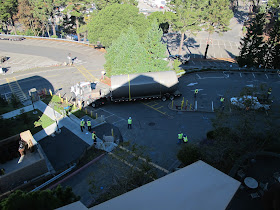Took some time out from the shop on Saturday to go watch the installation of a large storage tank for our magnet test facility. We have needed a storage vessel to recover the Helium we put into the magnet cryostat in the form of liquid during a magnet test, and the helium that is vented during magnet quenches. We have a large compressor as part of the cryoplant that recycles and re-compresses the vented gas and sends it to storage tanks on the roof of the building. The refrigerator part of the cryoplant then takes that gas and cools it to makes liquid helium to refill what was lost in the cryostat. This refrigeration gas cycle goes on for several weeks during a typical magnet test. For years we have not had enough gas storage capacity to recover all the helium we put into the refrigeration cycle during a test. This is wasteful and getting much more expensive. Helium is recovered as a by product of natural gas drilling. Some gas wells have a high enough concentration of Helium to make the recovery worth while. Contrary to popular belief this is the main method of Helium production. It occurs as a natural conversion of radioactive decay of heavy elements in the Earths crust. There is not much Helium in the atmosphere so separating out Helium from the atmosphere is not practical.
In the past few years the price per liter of Helium has steadily increased to its current level of $12 per liter of liquid Helium delivered in a dewar. This has made the investment payback for a larger storage system more attractive. We have been preparing for several major upgrades to our magnet test facility and a large high pressure helium recovery tank is big part of those improvements. Saturday was supposed to be the day of the installation. I took a ride out with my camera to watch the show.
Bigge crane and rigging got the contract to install the big tank on its concrete footing. The crane and rigging has been the toughest part of the tank installation. Access and crane capacities have hampered the process. Last week a plan was finally set that everybody signed off on.
Here is a shot of the tank were installing behind the test facility building. Its hard to tell how big it is from this long shot but the tank is twelve feet in diameter and thirty five feet tall and weighs around 70,000 lbs.
This was my vantage point for some of the pictures. Two cranes are required to stand the tank upright in the alley between the two buildings. The weight of the tank makes the available reach of the large crane short so the truck driver has to get pretty close.
Here the crane is hoisting more counterweights to add the the turret.
Another shot of the counterweights going on. It was some impressive maneuvering to get the mobile crane back behind the building.
In this picture you can see the tight space the crane is in. The tank ultimately sits on the round concrete footing at the bottom of the stairs.
The first attempt was to back the tank up a steep off camber hill into position. The low boy trailer grounded out in a dip and stopped the show.
Second try just driving up the hill got the tank closer, but not close enough. The main beams of the trailer grounded out on a hump and ground the tank to a halt. A stop work was called to review the plan and come up with another solution to the rigging problem. About this time I had to leave so maybe when I get back into the office on Monday I'll have a nice big Helium tank behind my office. This last picture gives you an idea how big this thing is. Its rated working pressure is 250 psi. If they cant install it at our building maybe I can get it for scrap and use it as air tank for my compressor. Fill it once per year.
More to follow.







That is an absolutely massive storage tank! It’s a wonder how the team managed to hoist the storage tank. Well, now you can store all the liquid helium in there after the refrigerator cycle. But safety measures must be made to make sure that it doesn’t seep out accidentally. Helium can have negative effects on people when inhaled. For one, they can experience asphyxia and be deprived of oxygen.
ReplyDelete@Richelle Loughney
Hi Richelle,
ReplyDeleteWe finally got the tank installed. This particular tank is for storage of high pressure helium. When we quench one of our large magnets a portion of the liquid helium converts to gas. We capture this gas instead of venting it to the atmosphere. We need such a large tank because the expansion ratio of liquid helium to gaseous helium changes volume by a factor of 710 to one. Maximum pressure for our big tank is 250psi.
Thanks for posting.
Tom
This comment has been removed by the author.
ReplyDelete